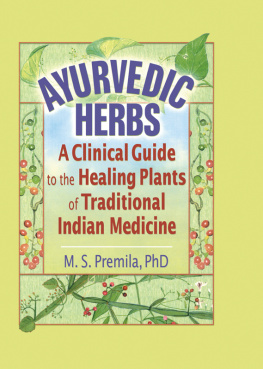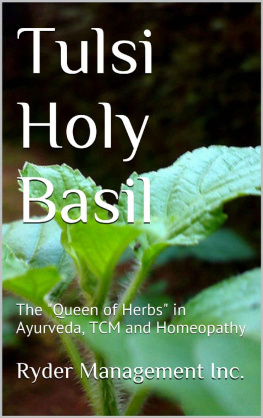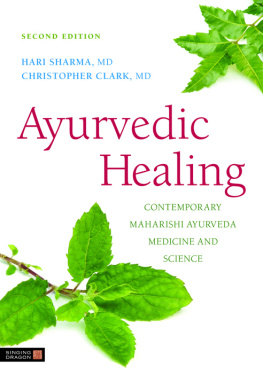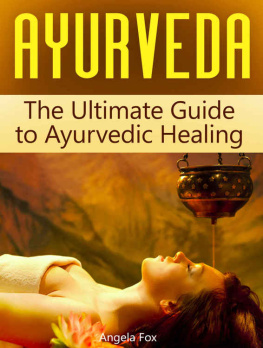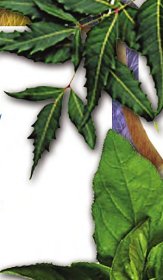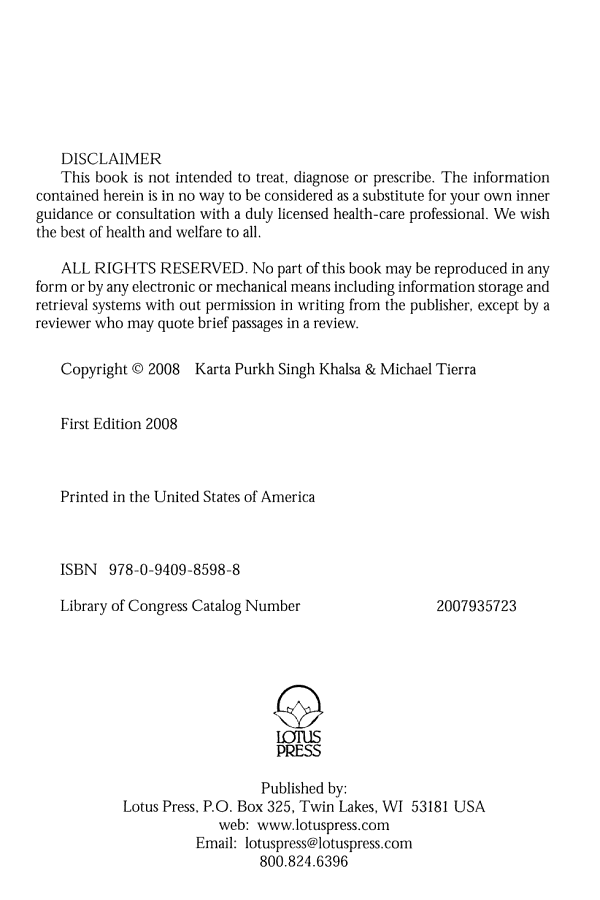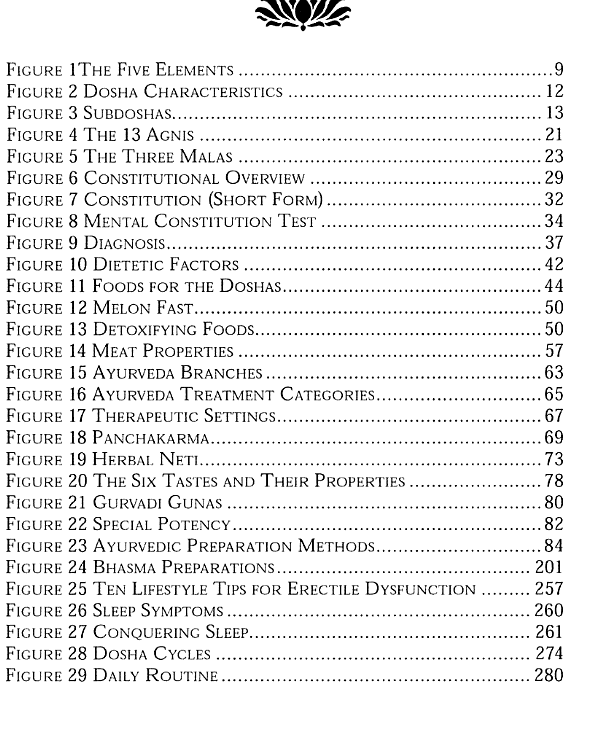AYURVEDIC HERBS
A Contemporary Introduction and Useful Manual for the Worlds Oldest
Healing System
Ashwaganda forstaminaandvitality... arjuna forhearthealth... dandelion forbreastwellness...gokshura to reachasexual peak... Traditional Ayurveda, using the principlesofthethree
doshas, constitutional body typing and highly individualized
therapies, is the oldest continuously practiced healing system
on Earth. Over those many centuries, generations of Ayurvedic
scholarsandphysicianshavereviewed,inspected,dissectedandrefinedthesystemtoperfectahighlyeffectiveformofhealth,balanceandhealing.Now,twooftheworlds
leading Ayurvedic herbalists, both leaders of the ho
listic health renaissance, and who, together, bring a
total of over 75 years of practice to the work, have
crafted a manual for making Ayurveda understand
able and eminently, practically useful. THE WAY OF
AYURVEDIC HERBS is more than an herb manual. It
is a life path to well-being.
Discover:
Your own Ayurvedic body type
The three doshas, master forces that regulate the body in health
and disease
Living an Ayurvedic lifestyle from rising until bedtime
Food therapy... living healthy with an Ayurvedic kitchen
Hundreds of Ayurvedic herbs and formulas for common health problems,
including acne, anxiety, cold and flu, diabetes, headache, insomnia and obe
sity
Ayurvedic detoxification programs to keep you strong and clean
Detailed methods for procuring, using and integrating Ayurvedic herbs into
daily life... and much more
Ayurvedic herbology is the ancient Vedic science of healing the body, mind and spirit. It is evidentially proven
medicine that is traditionally accepted throughout India and abroad. the rasa (taste), virya (energy) and vipak
(post-digestive effect) of the herbs are beautifully explained in the ancient texts. This book will give the light of
Ayurvedic herbology to both the students and practitioners of herbology.
- Vasant Lad, B.A.M.S., M.A.Sc., Ayurvedic Physician and the author of Ayurveda: Science of Self Healing
A superb work on healing with Ayurveda and Herbs by two of the most advanced masters in the field. Let their
experience work for you. This is absolutely a must own book.
- Dharma Singh Khalsa, M.D. www.drdharma.com,
author of Food as Medicine
AUTHOR'S FOREWORD TO THE SERIES
Ayurveda, the traditional medicine of India, shares the distinction with Traditional Chinese Medicine (TCM) and Middle Eastern Unani Tibb Medicine as one of the three oldest surviving comprehensive herbal medicine systems on the planet. These are distinct insofar as, unlike local or native herbal medical systems, they evolved over a diverse cultural and geographical area to enable them to treat the most diverse variety of human diseases.
Even a cursory examination of the three systems will reveal a number of fundamental similarities, including the energetic classification of diseases and herbs, such as the use of cosmological theories with descriptive energetic medical terms, such as "hot," "cold," "damp," "dry" and "wind." Also, each is based on a similar "elemental" system, which was also the foundation of early GrecoRoman medicine.
In fact, there seems to be a common thread that forms the basis of the three great healing systems of the world, with similar approaches to healing, among apparently widespread and disparate cultures, ranging from India, China, to the Mediterranean and even extending to native cultures of the Americas, partially as a result of colonizing and pre-colonizing influences.
Could it be that there is a common wellspring of wisdom to all these healing systems? If so, much of it utilized a circular logic to represent our interconnection with all aspects of inner and outer nature. And just as early Asian and European systems used theories of four or five elements to represent an interdependent relationship with all aspects of being, so did Native North American Medicine use the Sacred Medicine Wheel, representing the four directions, north, south, east and west, and classified herbs as being heating cooling, moistening or drying, corresponding with their general effects on the sympathetic and parasympathetic nervous system.
Having evolved mostly as a self taught herbalist, with periods of intense study in all of these traditional healing methods, I was never satisfied to exclusively align myself to any single one of them. This inspired me to form the concept of Planetary Herbology that subsequently led to the publication of my book with the same title by Lotus Press. In it, I offer the possibility of a synthesis of essential elements from each of the primary three medical systems, Indian Ayurvedic, Traditional Chinese Medicine and Western herbalism, applying their medical classifications to the use of herbs from around the world.
This book is the third in "The Way" series beginning with The Way of Herbs and followed by The Way of Chinese Herbs (both published by Pocket books). While these were written based on my dominant clinical experience integrating Western and Chinese herbal systems into my practice, this, third one, on Ayurvedic Medicine, is written with my esteemed colleague, K.P. Khalsa, a well respected practitioner of Ayurvedic medicine.
Besides our close association as professional colleagues and friends in the American Herbalists Guild (AHG), our background also shares similarities. Independently, we both first learned Ayurvedic medicine from our respective spiritual mentors- myself, with Baba Hari Dass, and for K.P., with Yogi Bhajan. In fact, these two Indian teachers were probably the first to introduce traditional Ayurvedic medicine to North America. It was a fortuitous time finding a reception during those soul searching decades of roughly the 1960's and 70's - a time when the world was living under the 'cold war' between Russia and the West and the eminent threat of nuclear annihilation, racial upheaval and the Vietnam war. It was a time when many of the values and institutions of the mainstream were being questioned, including Western medicine.
Many of us, in the midst of searching for more natural lifestyle alternatives, including older systems of natural healing with homebirth, herbs and acupuncture, also discovered the ancient treasures of healing wisdom from diverse ethnic groups. The reward of those "years of questioning and searching" resulted in learning Traditional Native American Medicine, Chinese Medicine and Indian Ayurvedic medicine.


